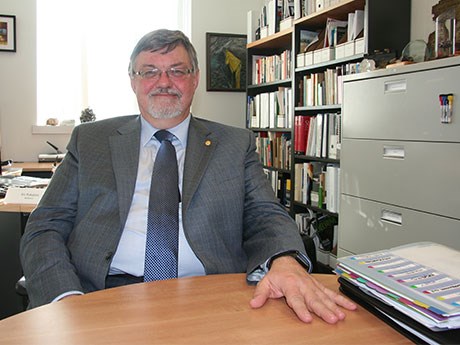New CEO boasts distinguished career in mining, public service and academia
Vic Pakalnis has come full circle with his appointment last summer as president and CEO of Sudbury-based MIRARCO Mining Innovation. A mining engineer with undergraduate and graduate degrees from McGill University, Pakalnis spent 10 years in Sudbury from 1975 to 1985.
While serving as the Ontario Ministry of Labour’s chief mining engineer in 1985, he shepherded the members of the Provincial Inquiry into Mining Safety and Emergency Preparedness – better known as the Stevenson Inquiry – to hearings around the province.
Prompted by a series of mining fatalities, including the death of four miners as a result of a rockburst at a Falconbridge mine on June 20th, 1984, the inquiry produced a total of 56 recommendations, many of which focused on the need for enhanced understanding of rock mechanics.
Research chairs in rock mechanics were established at the University of Toronto, Queen’s University and at Laurentian University in Sudbury. Laurentian’s chair, Peter Kaiser, went on to establish the Geomechanics Research Centre that, in turn, gave birth to MIRARCO.
During the quarter century following the conclusion of the inquiry, Pakalnis went on to a distinguished career in public service as director of the Ministry of Labour’s mining program and as regional director for Eastern Ontario.
Professor of Mining
In 2007, he made the move to academia - initially as Ontario Public Service Amethyst Fellow in Public Policy at Queen’s University’s School of Policy Studies. Two years later, he was named Kinross Professor of Mining and Sustainability at the university’s Robert M. Buchan School of Mining.
The opportunity to return to Sudbury as president and CEO of MIRARCO was appealing on several levels.
“What attracted me most was getting back to the north and my roots as a mining engineer,” said Pakalnis. “I was born in Northern Quebec and went to high school in Kirkland Lake. I come from a mining family. My father was a mining engineer and my brother taught mining at the University of British Columbia.”
Having an opportunity to take on a leadership role in rock mechanics research, a key recommendation of the Stevenson Inquiry during his tenure with the Ministry of Labour in Sudbury some 25 years earlier, was a bonus.
From its birth as a rock mechanics research organization, MIRARCO has grown to encompass several other areas of focus, including energy, renewables and carbon management, environmental monitoring and rehabilitation, ventilation and production optimization, as well as geohazard assessment and risk mitigation through the Geomechanics Research Centre.
“MIRARCO’s mission is to support the mining industry in terms of safe, productive and sustainable mining practices,” said Pakalnis.
Currently, MIRARCO is doing research on hydrofracturing for a project managed by for the Centre for Excellence in Mining Innovation, both of which occupy office space on the fourth floor research cluster of the Willet Green Miller Building on Laurentian University’s campus.
Using high-pressure water to destress rock would be “an amazing breakthrough,” said Pakalnis.
Energy savings
Dean Millar, MIRARCO Research Chair and Professor of Energy in Mining at Laurentian’s Bharti School of Engineering, is heading up MIRARCO’s 40 per cent mine project, which has as its objective a 60 per cent reduction in energy costs through the use of innovative, alternative technologies.
MIRARCO director Al Douglas is focused on climate change study, a serious issue impacting Northern regions generally, as well as mining companies that depend on ice roads for accessing remote sites.
Other MIRARCO research leads are Sean Maloney of the Geomechanics Research Centre, and Lorrie Fava, program manager for Ventilation and Production Optimization,
MIRARCO is also well known for its work on 3D visualization and its development of the Schedule Optimization Tool, which produces multiple scheduling scenarios in a fraction of the time it would take using traditional means.
Contract work for in situ stress determination is also carried out for external clients, including the Seymour Capilano Twin Tunnels project in North Vancouver and the Nuclear Waste Management Organization’s proposed Bruce repository in Ontario, as well as for mining companies.



